Willesden
Hospital
and Chest Clinic
and Chest Clinic
150 Harlesden Road, NW10 3RY
Medical
dates:
Medical
character:
Acute. Later, care of the elderly, other (including Younger Disabled Unit)
In the early 1890s the
population of Willesden stood at 60,000 but was increasing, as about
700 new houses were being built in the area each year. A Hospital
Building Committee,
under the Chairmanship of Sir E. Bradford Leslie, was formed to raise
funds for the building of a much needed hospital for the treatment and
relief of the sick poor of Willesden and surrounding districts.
Building work began on a half-acre site bought from All Souls' College, but it was soon apparent that there were inadequate funds to pay the builder or even to equip the Hospital. The Committee made a public appeal, but the only respondent was the philanthropist John Passmore Edwards. He donated £2,000 - the full costs of the building - so the money raised by the appeal was held in reserve for the future running costs and maintenance of the building.
Willesden Cottage Hospital was officially opened in July 1893 by Miss Balfour, accompanied by her brother, the Rt. Hon. A.J. Balfour, Parliamentary leader of the Opposition.
There were two wards on the ground floor, one for men and one for women, each containing 4 beds. The floors were bare, but each ward contained four bedside rugs. In the centre of each ward was a large table covered with a blue serge tablecloth with an amber daisy fringe. At one end of the table was a wash-hand basin and jug, covered with a white cloth, and on the other were trays and porringers prepared for surgical dressings. The bed coverlets were white and the window blinds blue.
The kitchen, with blue-patterned crockery displayed on dressers, was at the back of the building, as were the scullery, pantry and store cupboard. Nearby was the tiny operating theatre and an equally small room which was intended eventually to become a private patient's room.
The first floor of the building contained a small linen cupboard and bedrooms for the staff - one for the Matron, one for her Assistant Nurse and another for the domestic servant. From the back of the Hospital a view of open countryside could be seen, stretching towards Harrow.
Within three months the Hospital was running at full capacity.
After three years it was decided that the building should be extended and another public appeal for funds was launched, which proved as unsuccessful as the first. Again, Passmore Edwards stepped in and donated £2,500 for two new wings. Building work began in 1898 and the Hospital, now with 24 beds, was officially re-opened in May 1899 by Lady and Sir Henry Campbell-Bannerman. It was renamed the Passmore Edwards Hospital for Willesden.
During WW1 it was extended again to an additional 40 beds, and was affiliated as an auxiliary hospital to the Edmonton Military Hospital.
In 1918 a maternity pavilion was opened.
In December 1922 the first pavilion of the war memorial wing was officially opened by Viscount Burnham, who also unveiled a tablet commemorating the raising of £1,000 by the local schoolchildren for the new building. The new pavilion contained mainly single and 2-bedded rooms for private patients, each of whom paid between 3 to 6 guineas (£3.15-£6.30) a week. A second pavilion was built as accommodation for nursing and domestic staff. The Hospital was renamed the Willesden General Hospital.
On 30th April 1923 the maternity pavilion was closed. Maternity patients were then sent to the Park Royal Hospital. (This arrangement ceased on 14th February 1931 when the Willesden Maternity Hospital opened.)
Further additions were made in 1926 as the Hospital was extended to meet the needs of the population. During the first year of its operational life some 15 patients had been treated, and 88 in the second year. During 1905 some 251 had been treated, but the numbers increased yearly, and during 1915 the number had been more than doubled with 553 patients. 1897 cases had been treated in 1925 and 2556 in 1930.
In 1933 the Hospital had 106 beds in four wards - 'Passmore Edwards Ward', 'Fifoot Ward', 'Furness Ward' and 'Menzler Ward'. The exteriors of the buildings were repainted and, early in 1934, a temporary chapel was erected in the Hospital grounds.
During WW2 the Hospital joined the Emergency Medical Service(E.M.S.) with 136 beds (58 of which were E.M.S. beds). There were also 15 private patient rooms; a single room cost 18 shillings (90p) a day, and a shared double room 12 shillings (60p). In 1941 a First Aid Post and Cleansing Station was built by the Willesden Borough Council and the Hospital was graded a 'B' unit in the fracture service. In November the President of the Hospital, Lord Rochdale, opened the new Nurses' Home and unveiled a tablet naming the new it 'The Andrews Nurses' Home' in recognition of Mr and Mrs John Andrews, Patrons of the Hospital. In December a newly equipped X-ray Department opened.
After the war the Hospital experienced financial pressure following a steep rise in costs, especially for labour. Higher wages and shorter working hours resulted in an all-round increase in expenditure by £9,177. The cost of an in-patient per week rose to £7 11s 6d (£7.57) in 1946, compared to £6 1s 8d (£6.08) during the previous year. However, some improvements were made to the facilities; wash basins were installed in Fifoot and Furness wards, as well as a new wireless (radio) system. New easy chairs were purchased for all the wards. The Cleansing Station was converted into an Occupational Therapy Unit. The Hospital Committee began negotiations to take over St Monica's Hospital for use as additional accommodation.
In 1948 the Hospital joined the NHS under the control of Central Middlesex Group Hospital Management Committee, part of the North West Metropolitan Regional Hospital Board.
By 1950 the Hospital had 127 beds.
Following a major reorganisation of the NHS in 1974, the Hospital transferred to the control of the Brent and Harrow Health Authority, part of the North West Thames Regional Health Authority.
In 1982, after another reorganisation of the NHS, the Hospital was administered by the Parkside Health NHS Trust. It became Willesden Hospital, a geriatric hospital with 60 beds.
Willesden Hospital closed in 2005 when the new Willesden Centre for Health and Care opened on an adjacent site. The Centre, which incorporates some of the Hospital buildings, is currently managed by the North West London Hospitals NHS Trust.
Building work began on a half-acre site bought from All Souls' College, but it was soon apparent that there were inadequate funds to pay the builder or even to equip the Hospital. The Committee made a public appeal, but the only respondent was the philanthropist John Passmore Edwards. He donated £2,000 - the full costs of the building - so the money raised by the appeal was held in reserve for the future running costs and maintenance of the building.
Willesden Cottage Hospital was officially opened in July 1893 by Miss Balfour, accompanied by her brother, the Rt. Hon. A.J. Balfour, Parliamentary leader of the Opposition.
There were two wards on the ground floor, one for men and one for women, each containing 4 beds. The floors were bare, but each ward contained four bedside rugs. In the centre of each ward was a large table covered with a blue serge tablecloth with an amber daisy fringe. At one end of the table was a wash-hand basin and jug, covered with a white cloth, and on the other were trays and porringers prepared for surgical dressings. The bed coverlets were white and the window blinds blue.
The kitchen, with blue-patterned crockery displayed on dressers, was at the back of the building, as were the scullery, pantry and store cupboard. Nearby was the tiny operating theatre and an equally small room which was intended eventually to become a private patient's room.
The first floor of the building contained a small linen cupboard and bedrooms for the staff - one for the Matron, one for her Assistant Nurse and another for the domestic servant. From the back of the Hospital a view of open countryside could be seen, stretching towards Harrow.
Within three months the Hospital was running at full capacity.
After three years it was decided that the building should be extended and another public appeal for funds was launched, which proved as unsuccessful as the first. Again, Passmore Edwards stepped in and donated £2,500 for two new wings. Building work began in 1898 and the Hospital, now with 24 beds, was officially re-opened in May 1899 by Lady and Sir Henry Campbell-Bannerman. It was renamed the Passmore Edwards Hospital for Willesden.
During WW1 it was extended again to an additional 40 beds, and was affiliated as an auxiliary hospital to the Edmonton Military Hospital.
In 1918 a maternity pavilion was opened.
In December 1922 the first pavilion of the war memorial wing was officially opened by Viscount Burnham, who also unveiled a tablet commemorating the raising of £1,000 by the local schoolchildren for the new building. The new pavilion contained mainly single and 2-bedded rooms for private patients, each of whom paid between 3 to 6 guineas (£3.15-£6.30) a week. A second pavilion was built as accommodation for nursing and domestic staff. The Hospital was renamed the Willesden General Hospital.
On 30th April 1923 the maternity pavilion was closed. Maternity patients were then sent to the Park Royal Hospital. (This arrangement ceased on 14th February 1931 when the Willesden Maternity Hospital opened.)
Further additions were made in 1926 as the Hospital was extended to meet the needs of the population. During the first year of its operational life some 15 patients had been treated, and 88 in the second year. During 1905 some 251 had been treated, but the numbers increased yearly, and during 1915 the number had been more than doubled with 553 patients. 1897 cases had been treated in 1925 and 2556 in 1930.
In 1933 the Hospital had 106 beds in four wards - 'Passmore Edwards Ward', 'Fifoot Ward', 'Furness Ward' and 'Menzler Ward'. The exteriors of the buildings were repainted and, early in 1934, a temporary chapel was erected in the Hospital grounds.
During WW2 the Hospital joined the Emergency Medical Service(E.M.S.) with 136 beds (58 of which were E.M.S. beds). There were also 15 private patient rooms; a single room cost 18 shillings (90p) a day, and a shared double room 12 shillings (60p). In 1941 a First Aid Post and Cleansing Station was built by the Willesden Borough Council and the Hospital was graded a 'B' unit in the fracture service. In November the President of the Hospital, Lord Rochdale, opened the new Nurses' Home and unveiled a tablet naming the new it 'The Andrews Nurses' Home' in recognition of Mr and Mrs John Andrews, Patrons of the Hospital. In December a newly equipped X-ray Department opened.
After the war the Hospital experienced financial pressure following a steep rise in costs, especially for labour. Higher wages and shorter working hours resulted in an all-round increase in expenditure by £9,177. The cost of an in-patient per week rose to £7 11s 6d (£7.57) in 1946, compared to £6 1s 8d (£6.08) during the previous year. However, some improvements were made to the facilities; wash basins were installed in Fifoot and Furness wards, as well as a new wireless (radio) system. New easy chairs were purchased for all the wards. The Cleansing Station was converted into an Occupational Therapy Unit. The Hospital Committee began negotiations to take over St Monica's Hospital for use as additional accommodation.
In 1948 the Hospital joined the NHS under the control of Central Middlesex Group Hospital Management Committee, part of the North West Metropolitan Regional Hospital Board.
By 1950 the Hospital had 127 beds.
Following a major reorganisation of the NHS in 1974, the Hospital transferred to the control of the Brent and Harrow Health Authority, part of the North West Thames Regional Health Authority.
In 1982, after another reorganisation of the NHS, the Hospital was administered by the Parkside Health NHS Trust. It became Willesden Hospital, a geriatric hospital with 60 beds.
Willesden Hospital closed in 2005 when the new Willesden Centre for Health and Care opened on an adjacent site. The Centre, which incorporates some of the Hospital buildings, is currently managed by the North West London Hospitals NHS Trust.
Present status (April 2008)
The £20m PFI-built Willesden Centre for Health and Care, containing a community rehabilitation hospital with 72 beds, was officially opened in May 2006 by the Earl of Wessex. It has its main entrance in Robson Avenue.
The facade of one of the original buildings at the entrance in Harlesden Road still remains.
A housing development with 2-bedroom apartments and 2-bedroom townhouses - Robson Place - was built by Bellway on the southern portion of the site.
Update: June 2016
The Willesden Centre for Health and Care is now under the control of the Central London Community Healthcare NHS Trust. The community rehabilitation hospital within it contains two 20-bedded wards - Fifoot Ward and Robertson/Menzier Ward.
The £20m PFI-built Willesden Centre for Health and Care, containing a community rehabilitation hospital with 72 beds, was officially opened in May 2006 by the Earl of Wessex. It has its main entrance in Robson Avenue.
The facade of one of the original buildings at the entrance in Harlesden Road still remains.
A housing development with 2-bedroom apartments and 2-bedroom townhouses - Robson Place - was built by Bellway on the southern portion of the site.
Update: June 2016
The Willesden Centre for Health and Care is now under the control of the Central London Community Healthcare NHS Trust. The community rehabilitation hospital within it contains two 20-bedded wards - Fifoot Ward and Robertson/Menzier Ward.

The original buildings remaining in Harlesden Road are at the back of the new site.
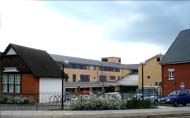
The new Willesden Centre for Health and Care can be glimpsed beyond the old facade.
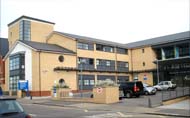
The Community Rehabilitation Hospital is within the Willesden Centre for Health and Care.
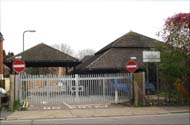
The Council owned Millenium Day Centre at the south end of the site.

The central section of the building is now the Mental Health Resource Centre.
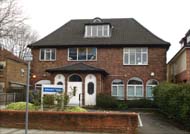
Belvedere House, a former Day Hospital, on the opposite side of Harlesden Road.
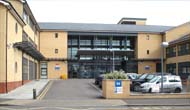
The main entrance in Robson Avenue.
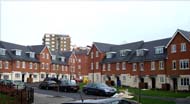
New Housing on the south side of the site.
Readers' comments
These old letters were written by my brother Richard (Dick, Dicky) Palmer - he was in hospital with an adenoid problem in 1938 and again in 1939. His birthday was on 19th April and he was born in 1930. The letters were written when he was 9 and 9 years old. He died in 2015, aged 85.
Apparently eggs were sent to him in hospital! (My parents always kept chickens.)
Cilla King
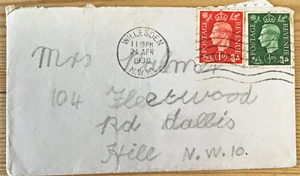
Letter posted on 24th April 1938
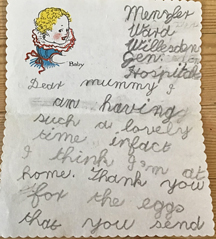

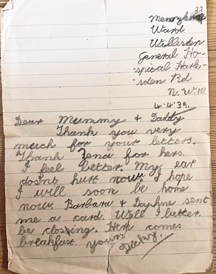
(Author unstated) 1893 The new Willesden Cottage Hospital. The Nursing Record Hospital World Supplement, 17th August, 22-23.
(Author unstated) 1898 Reflections from a Board Room Mirror. The Nursing Record and Hospital World, 12th February, 137.
(Author unstated) 1917 List of the various hospitals treating military cases in the United Kingdom. London, H.M.S.O.
(Author unstated) 1923 Willesden War Memorial Hospital. British Medical Journal 1 (3237), 79.
(Author unstated) (undated - ? 1954) Surrey Branch British Red Cross Society. Historical Surray April 1907 - 31st December 1953. Aldershot, John Drew.
https://hansard.parliament.uk
https://wellcomelibrary.org
www.birpublications.org
www.bonhams.com
www.britainfromabove.org.uk
www.british-history.ac.uk
www.flickr.com (1)
www.flickr.com (2)
www.flickr.com (3)
www.geograph.org.uk (1)
www.geograph.org.uk (2)
www.passmoreedwards.org.uk
Return to home page